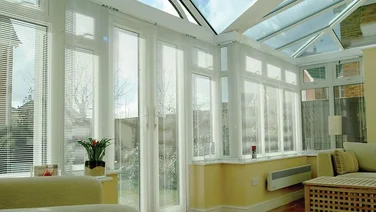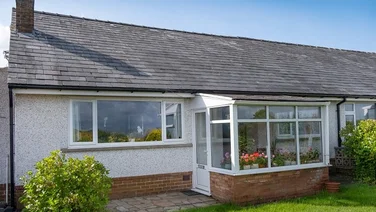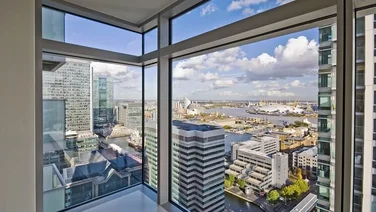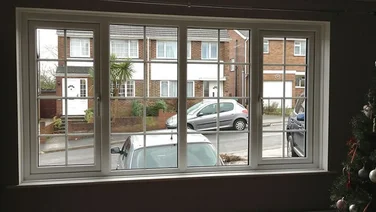- Blinds and shutters serve similar functions but differ in design, installation, and materials.
- Choosing between blinds and shutters depends on window type, room function, budget, and aesthetics.
- Shutters are often seen as an architectural feature, while blinds provide a more versatile and budget-friendly alternative.
One of the best ways to get some privacy at home is to add shutters or blinds to your windows. Both options are excellent, and they come with other added benefits like free cooling from the summer’s sun.
Shutters provide a timeless, durable solution that enhances home security and value, while blinds offer flexibility, affordability, and easier installation. The choice depends on factors like window type, budget, and lifestyle needs.
From insulation to maintenance, each has its strengths—so which is best for you? Let’s find out.

Shutters vs blinds: which should I choose?
Blinds and shutters provide similar functions but have some key differences. The first is that shutters tend to consist of hinged panels that are typically fitted to the outside of a window. While they can also be fitted inside, they are primarily designed to provide privacy, shade, and/or increase security to a window.
On the other hand, blinds tend to be fixed internally and can either be attached directly to the window’s frame or the recess above a window. Blinds offer many of the same benefits as shutters but don’t quite have the big security benefit.
The next main difference is the type of material used to make them. Shutters are sturdy and typically made of hard materials like wood, metal, or vinyl. Blinds, however, tend to be softer, often made of fabric or thin metal, plastic, or wood.
Of the two, shutters are considered more of an architectural feature and are generally more permanent than blinds, which can be changed easily and whenever you want.
Where shutters are expensive and could add value to your home, blinds are cheaper and probably won’t help much if and when you sell.
Both options are great. In the case of shutters, these are the pros and cons.
| Pros | Cons |
|---|---|
| Durable and long-lasting | Generally more expensive than blinds |
| Shutters are generally a very attractive addition to your windows | Occupy more space in windows |
| No need for cords or chains, making them brilliant additions for homes with young children | Tend to be heavy, making them unsuitable for some windows |
| Very low maintenance and are easy to clean | Installation is more complex and expensive |
| They tend to come in a range of materials, such as vinyl, wood, PVC, and faux wood | Changing or replacing shutters is more complicated and expensive compared to blinds |
| Shutters provide great shading and ventilation in the room |
These are the pros and cons of blinds:
| Pros | Cons |
|---|---|
| Tend to come in a huge variety of colours, styles, and designs | More effort is required to keep blinds clean |
| Different materials make blinds a good option for any style of interior design | Fabric blinds will suffer sun damage and bleaching over time |
| Blinds offer a softer look in a room compared to shutters | Fabric blinds are susceptible to water or moisture damage |
| More affordable than shutters | Need to be replaced more frequently than shutters |
| Easy to change or upgrade | |
| Options are usually available for ultimate blackout and improved insulation |
Different types of shutters
As you might expect, shutters come in various sizes, styles, colours, and shapes. They can also be made from multiple materials, from wood to vinyl and even metal, and they can fit pretty much any window.
That being said, some of the most common include, but are not limited to, the following:
- Interior (AKA “plantation”) shutters
These typically cost between £180 and £300 per square metre, and offer increased privacy without compromising on light flow.
- Exterior shutters
Costing anywhere between £160 and £360 per square metre, these are what you might call the the ‘classic’ kind. They are ideal for protecting your home and windows from extreme weather, saving on heating bills, and adding home security.
- Cafe-style shutters
These types of shutters cover the bottom half of windows and can be solid paneled or louvered (fixed or moveable), with costs varying between about £200 and £325 per meter squared.
- Bay window shutters
As the name suggests, these kinds of shutters are specially designed to fit bay windows. Since these kinds of windows tend to be larger, costs ranging from £180 to £360 per meter squared are slightly higher.
Technically a sub-species of plantation shutters, these shutters consist of a pair of top and bottom sections often made of hardwood. Each “tier” can be independently adjusted and offers the maximum customization for light and privacy. Being more complex, they are some of the most costly, with prices coming in at the higher end for plantation shutters.
- Shaped shutters
These are the most labour-intensive kind as they tend to require tailored design and construction for things like conservatories and orangeries. As they require tailored design and construction, prices for these are usually on a job-by-job basis.
- Solid shutters
The best choice for more traditional homes, solid panel shutters, as the name suggests, are decorated with solid pieces of miniature doors for closing off windows. Fantastic for blocking out light, they come in various designs, sizes, colours, and materials. Costs range from £50 per meter-squared (e.g., pine) to £300 per meter-squared (for say, mahogany).
If you have French doors or want shutters for your patio doors, then tracked shutters might be your best choice. Mounted or a track fixed to the floor and ceiling, these shutters can be pushed to the sides when open. Since they are complex by design, costs will likely be similar to tailormade solutions like shaped shutters.
Costs of shutters
Shutter costs are hopefully much less than you may have been led to believe. There are options for most budgets, with cheaper alternatives for more expensive materials like mahogany with, say, plastic, if you are on a tight budget.
That being said, shutters do cost more than curtains, but their much higher durability and, frankly, cool factor make them a wise investment in the long run. For most homeowners, you can likely expect to pay about £250 per metre-squared, but this will vary depending on the product and complexity of installation.
| Shutter type | Price range |
|---|---|
| Interior (Plantation) Shutters | £180 – £300 per square metre |
| Exterior Shutters | £160 – £360 per square metre |
| Cafe-style Shutters | £200 – £325 per square metre |
| Bay Window Shutters | £180 – £360 per square metre |
| Tier-on-tier Shutters | Similar to higher end plantation shutters |
| Shaped Shutters | Likely needs to be tailormade |
| Solid Shutters | £50 – £300 per square metre |
| Tracked Shutters | Likely needs to be tailormade |
Different types of blinds
- Roller blinds
Roller blinds are the classic blind you’re probably most familiar with. Typically made from a single piece of opaque fabric wrapped around a tube, these are the simplest and most versatile type of blind. They come in various sizes, colours, patterns, and materials and typically cost between £25 and £45 per blind to install, depending on size. Costs can be cut significantly if you are confident enough to install yourself.
- Venetian blinds
Venetian blinds are similar to roller blinds but differ because they consist of horizontal slats. These blinds offer precise lighting control and can be made of wood, metal, or faux (fake) wood. Costs typically range from £50 to £100 for supply and fitting, but it can be much cheaper if you are good at DIY.
- Vertical blinds
Vertical blinds comprise vertical slats ideal for covering large windows or patio doors. They offer excellent light control and can be attractive to your internal decor. The cost typically ranges from £35 to £45 per blind for supply and installation.
- Roman blinds
Roman blinds are the fancier kind that tend to fold into pleats when retracted. They are elegant, can be made of various fabrics, and come in many designs. Costs typically range from between £50 to £70 for supply and fitting.
- Cellular (Honeycomb) Blinds
These blinds are designed with a cellular structure and provide excellent insulation and energy efficiency. They are available in various colours and opacities—costs range between £40 and £90 per blind.
- Panel Blinds
Ideal for large windows or as room dividers, panel blinds consist of wide fabric panels that slide along a track. They offer a contemporary look and are available in various fabrics. Prices vary based on size and material, so obtaining supplier quotes is advisable.
- Electric Blinds
Motorized for convenience, electric blinds can be controlled remotely, making them ideal for hard-to-reach windows. They are available in various styles, including roller and Venetian. The cost ranges between £60 and £140.
Costs of blinds
As you can see, blinds, on the whole, tend to be a cheaper option for providing shading and privacy than shutters. However, as mentioned, they may not be as aesthetically pleasing as the latter.
That being said, some blinds have the added benefit of being much more straightforward to install and change yourself. Costs will vary widely depending on the style, type, size, and material you choose.
| Blind Type | Approximate Cost |
|---|---|
| Roller Blinds | £25 – £45 per blind |
| Venetian Blinds | £50 – £100 per blind |
| Vertical Blinds | £35 – £45 per blind |
| Roman Blinds | £50 – £70 per blind |
| Cellular (Honeycomb) Blinds | £40 – £90 per blind |
| Panel Blinds | Varies based on size/material |
| Electric Blinds | £60 – £140 per blind |
Choosing the best shutter or blind: things to consider
- Type of window
Large windows like bifold or French doors suit blinds, such as Duette (AKA Honeycomb) blinds, which don’t obstruct handles. Shutters are often the better choice for arched, period, or rounded windows but will likely need tailored solutions to fit. Standard windows work well with either, so the choice depends on your style preference and functionality.
- Room suitability
Bedrooms benefit from blackout blinds for better sleep. Kitchens and bathrooms require moisture-resistant options, so vinyl shutters or waterproof blinds are probably more practical. Living and dining areas benefit most from light control and aesthetics, making both options viable depending on personal style and décor.
- Budget considerations
Shutters are generally more expensive than blinds but offer durability and home value. Made-to-measure options cost more than off-the-shelf choices. Setting a budget and comparing quotes from multiple experts ensures you get the best value without overspending.
- Durability and lifespan
High-quality shutters last longer than budget blinds, which may need replacing sooner. Classic, well-made designs stay stylish over time. If longevity is a priority, investing in durable shutters or premium blinds will save money on replacements in the long run.
- Energy efficiency
Shutters provide better insulation, reducing heat loss in winter and keeping rooms cool in summer. Honeycomb blinds (e.g., Duette) also improve insulation by trapping air. If energy savings matter, shutters or cellular blinds are the best choices.
- Ease of maintenance
Shutters are easy to clean with a simple wipe-down. Blinds, especially fabric ones, collect dust and may need more frequent cleaning. If low maintenance is a priority, choose shutters or blinds made from durable, easy-to-clean materials.
- Personal taste
The right choice depends on your home’s style and your preferences. Shutters offer timeless elegance, while blinds provide more variety in colors and patterns. Since you’ll see them daily, pick an option that makes you happy and enhances your décor.
Summary
- Assess your needs carefully before choosing. If security and long-term durability are priorities, shutters may be the better choice. If affordability and flexibility matter more, blinds might be preferable.
- Consider long-term value. While shutters may cost more initially, they add home value and last longer than most blinds.
- Think about maintenance. Shutters are easier to clean, while blinds, especially fabric ones, may require more upkeep.
- Energy efficiency can be a deciding factor. Shutters and honeycomb blinds improve insulation, helping reduce heating and cooling costs.
- Style and personal preference matter. Whether you choose blinds or shutters, pick an option that complements your home’s aesthetic and makes you happy daily.






